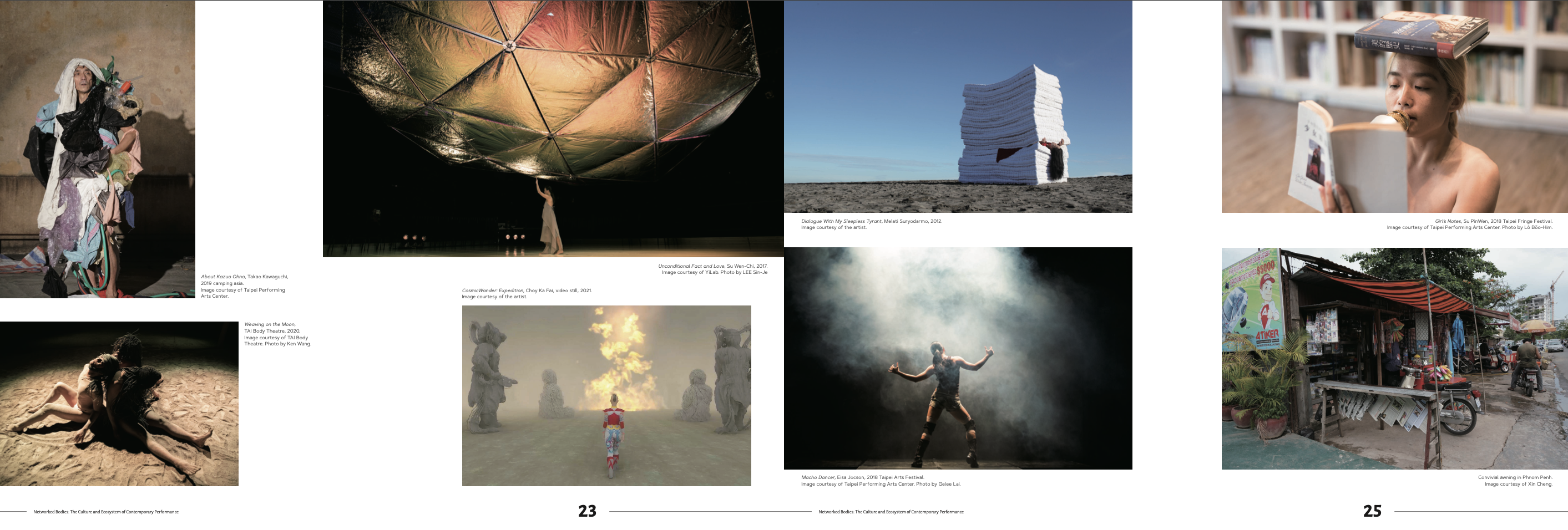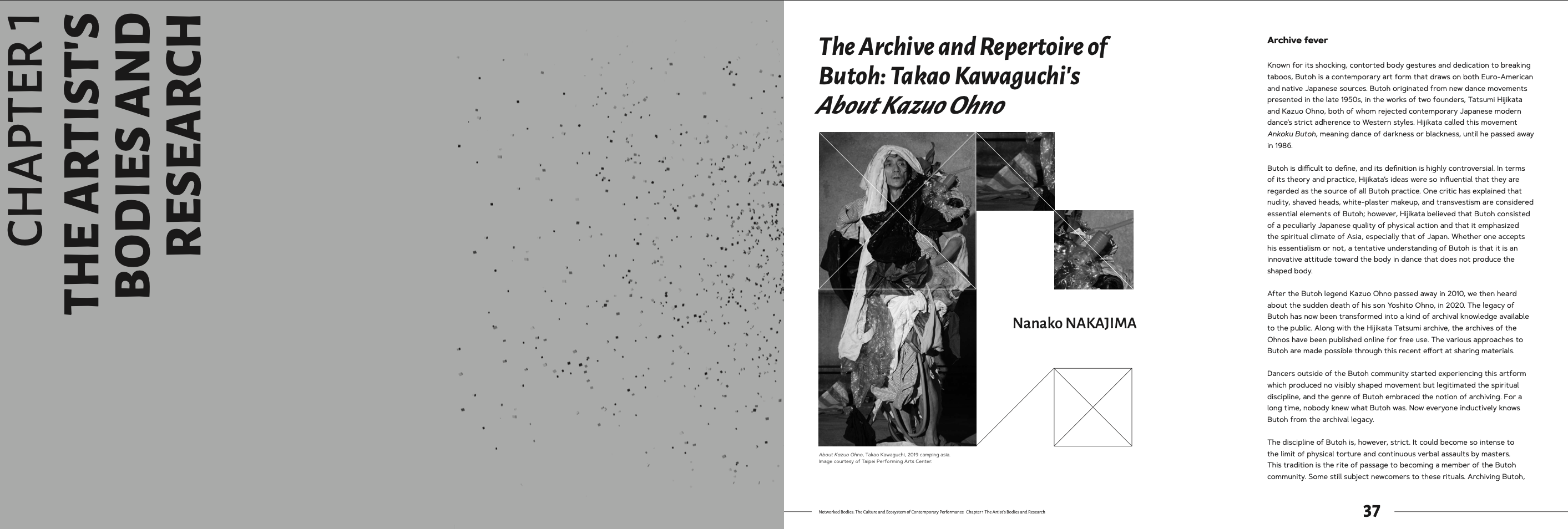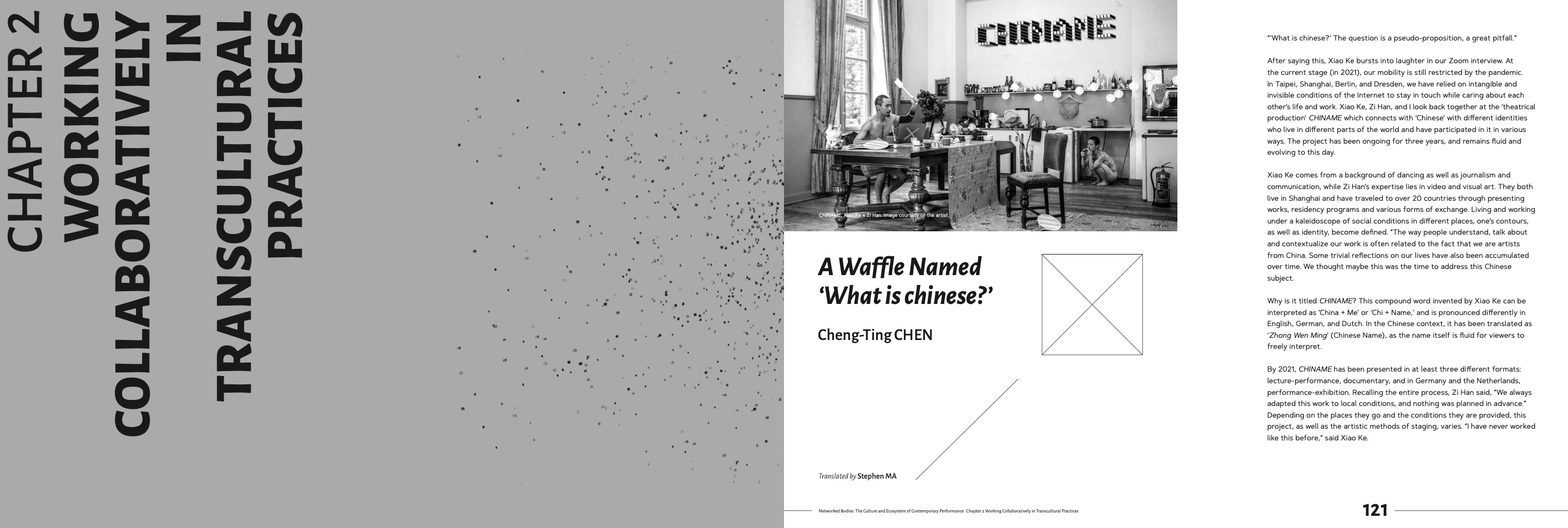Networked Bodies: the culture and ecosystem of contemporary performance
Asia Discovers Asia Meeting for Contemporary Performance 2017-2021
Edited by River Lin
︎ English e-book
︎ English paperback
︎ 中文電子書
︎ 中文紙本書






Introduction
by River Lin
This book is based on the exchanges, research and practices undertaken by artists from across the Asia-Pacific region and beyond who have worked with performance as a medium, form and method during the 2017-2021 editions of ADAM (Asia Discovers Asia Meeting for Contemporary Performance). It proposes or questions work-in-progress modes of knowledge production in the glocal context of contemporary performance. This publication documents the trajectory of ADAM, and further expands the discursive process for the problematique related to issues such as geopolitics, community and social engagement, cross-cultural studies, and interdisciplinary art. As the curator of ADAM, my work is to continuously explore and stir these speculations with artists, and stage how they choreograph, sculpt, concoct and circulate their thoughts and findings performatively.
Through a point-line-plane approach, Networked Bodies: The Culture and Ecosystem of Contemporary Performance looks at the performance process in three aspects: the individual practices of artists, collaborations between artists, and the art ecosystem. This composition presents how contemporary art, society and culture have intertwined into an intricate network (alas, this publication explores only a part of it).
The first chapter, “The Artist’s Bodies and Research,” examines the creative research and development behind live works and actions of performance, dance, theatre, new media and visual artists. The specific histories, social progresses and contemporary cosmoses connected to the inner recesses of their bodies enlighten us on how the body can be used as a language and instrument of fieldwork, as well as how artistic research is replete with process-oriented performativity. “Working Collaboratively in Transcultural Practices,” meanwhile, is a collection of artists’ firsthand experiences of collaborations and back-and-forth dialogues. The various exchanges and reflections between them catalyze experimental discourses of cross-cultural practices beyond theoretical frameworks. The third chapter, “Mapping the Art Ecosystem”, depicts the intersections of the artist community, contemporary society and the institutional realm in the 21st century context. It charts where we are presently and stimulates our understanding of how different hues of cultural and art practitioners have together colored the ecosystem, including all the contributors to this book: artists, curators, academics, art critics, producers, members of cultural institutions and the like.
There is, however, no single understanding or consensus of ‘Asia as method’ in these networked bodies. The way a piece is situated and associated with other pieces in the same or another chapter of this publication suggests how discourses could be questioned, rather than being installed. It invites readers and arts practitioners to reflexively rethink about ‘who’ is perceiving and rehearsing the notions of ‘Asia,’ ‘inter-Asianness’ and ‘contemporaneity’ – for ‘what,’ from ‘where’ and ‘how’ – as well as what cultural imaginations have arguably been articulated or withdrawn amidst it all.
ADAM was initiated in a bid to build a cultural infrastructure that is open-minded and heterogeneous, as well as to seek a decentralized and non-binary discourse on contemporary performance culture through the research and practices of artists. As a publication that transforms on-site happenings, making-of processes and echoes into knowledge production, this book also responds to the social and arts ecosystem impacted by COVID-19. With the opening of Taipei Performing Arts Center in 2022, ADAM continues to investigate the networks and bodies of Asian and global contemporary art and performance through this book.
by River Lin
This book is based on the exchanges, research and practices undertaken by artists from across the Asia-Pacific region and beyond who have worked with performance as a medium, form and method during the 2017-2021 editions of ADAM (Asia Discovers Asia Meeting for Contemporary Performance). It proposes or questions work-in-progress modes of knowledge production in the glocal context of contemporary performance. This publication documents the trajectory of ADAM, and further expands the discursive process for the problematique related to issues such as geopolitics, community and social engagement, cross-cultural studies, and interdisciplinary art. As the curator of ADAM, my work is to continuously explore and stir these speculations with artists, and stage how they choreograph, sculpt, concoct and circulate their thoughts and findings performatively.
Through a point-line-plane approach, Networked Bodies: The Culture and Ecosystem of Contemporary Performance looks at the performance process in three aspects: the individual practices of artists, collaborations between artists, and the art ecosystem. This composition presents how contemporary art, society and culture have intertwined into an intricate network (alas, this publication explores only a part of it).
The first chapter, “The Artist’s Bodies and Research,” examines the creative research and development behind live works and actions of performance, dance, theatre, new media and visual artists. The specific histories, social progresses and contemporary cosmoses connected to the inner recesses of their bodies enlighten us on how the body can be used as a language and instrument of fieldwork, as well as how artistic research is replete with process-oriented performativity. “Working Collaboratively in Transcultural Practices,” meanwhile, is a collection of artists’ firsthand experiences of collaborations and back-and-forth dialogues. The various exchanges and reflections between them catalyze experimental discourses of cross-cultural practices beyond theoretical frameworks. The third chapter, “Mapping the Art Ecosystem”, depicts the intersections of the artist community, contemporary society and the institutional realm in the 21st century context. It charts where we are presently and stimulates our understanding of how different hues of cultural and art practitioners have together colored the ecosystem, including all the contributors to this book: artists, curators, academics, art critics, producers, members of cultural institutions and the like.
There is, however, no single understanding or consensus of ‘Asia as method’ in these networked bodies. The way a piece is situated and associated with other pieces in the same or another chapter of this publication suggests how discourses could be questioned, rather than being installed. It invites readers and arts practitioners to reflexively rethink about ‘who’ is perceiving and rehearsing the notions of ‘Asia,’ ‘inter-Asianness’ and ‘contemporaneity’ – for ‘what,’ from ‘where’ and ‘how’ – as well as what cultural imaginations have arguably been articulated or withdrawn amidst it all.
ADAM was initiated in a bid to build a cultural infrastructure that is open-minded and heterogeneous, as well as to seek a decentralized and non-binary discourse on contemporary performance culture through the research and practices of artists. As a publication that transforms on-site happenings, making-of processes and echoes into knowledge production, this book also responds to the social and arts ecosystem impacted by COVID-19. With the opening of Taipei Performing Arts Center in 2022, ADAM continues to investigate the networks and bodies of Asian and global contemporary art and performance through this book.
引言
by 林人中
by 林人中
本書奠基在「亞當計畫」於2017至2021年間,呈現亞太及各地藝術家透過表演作為媒介、型態與方法所進行的交流、研究與實踐上,試圖在當代表演的全球在地語境裡提出或提問一種「仍處於過程中」的知識生產。它記錄了這個計畫平台的生成與運動軌跡,更進一步延展與地緣政治、社群與社會參與、跨文化研究及跨域藝術等相關問題意識的交往。作為計畫主持人,我的工作是與藝術家一同持續地挖掘、攪動問題,並將他們舞動、雕塑、料理及循環諸類思辨的行動佈置成一場表演。
沿著點線面的途徑,《身體網絡:當代表演的文化與生態》將這些充滿表演性的操練過程放置在藝術家個體、合作及藝術生態系統三個面向,來描繪當代藝術的身體、社會與文化如何交織成一個盤根錯節的網絡(而本書所盡之境只是網絡中的局部)。
第一部:「藝術家的身體與研究」呈現行為、舞蹈、劇場、新媒體及視覺藝術家們的現場展演與行動背後的創作研究與發展。他們的身體內部與所相連的特定歷史、社會過程及當代空間,啟發我們身體如何作為田調的語言與工具,而創作研究又如何充滿了以過程為目的的表演性。
第二部:「合作和跨文化實踐」採集了藝術家們合創與交互答辯的第一手經驗。藉由他們之間的各類撞擊與交流,展現跨文化實踐在理論框架外可能的實驗性論述。
第三部:「測量藝術生態」則書寫藝術家社群、當代社會及21世紀以降機構產業之間的對話與回應。進一步幫助我們檢視此時此刻身在何方,及各職類藝術工作者如何一同構築了生態,也包括這本書的所有作者:藝術家、策展人、學者、藝評人、製作人及文化機構成員等。
值得留意的是,這個身體網絡所概括的各種見解,並不存在單一、固定的對於「亞洲作為方法」的共識與理解。單篇文章需與同部或另一部裡的另一篇或幾篇文章對話,才可能產生立足點。因此,與其說這本書「構成了」一部論述,不如說,它其實「提問了」論述本身如何構成,更「邀請著」讀者及藝術從業者進入反身批判性的思考空間:關於「誰」、「在哪裡」、「為了誰」、「用什麼立場」,在觀看與排練「亞洲」、「亞際」及「當代」──而當中,又存在著什麼樣的文化與想像間的接合或背離。
亞當計畫的起心動念為要搭建一個開放且異質性的基礎設置,並藉由藝術家的研究與實踐,去尋找去中心且非二元對立式的當代表演文化論述。這本將工作現場的實況、幕後及反響轉化為意義生產的讀本,也回應了新冠疫情對社會及藝術生態系統造成的衝擊與改變。2022年,隨著臺北表演藝術中心開幕,亞當計畫以此書繼續提問,在亞洲與全球當代藝術裡擾動那不穩定的網絡與身體。
沿著點線面的途徑,《身體網絡:當代表演的文化與生態》將這些充滿表演性的操練過程放置在藝術家個體、合作及藝術生態系統三個面向,來描繪當代藝術的身體、社會與文化如何交織成一個盤根錯節的網絡(而本書所盡之境只是網絡中的局部)。
第一部:「藝術家的身體與研究」呈現行為、舞蹈、劇場、新媒體及視覺藝術家們的現場展演與行動背後的創作研究與發展。他們的身體內部與所相連的特定歷史、社會過程及當代空間,啟發我們身體如何作為田調的語言與工具,而創作研究又如何充滿了以過程為目的的表演性。
第二部:「合作和跨文化實踐」採集了藝術家們合創與交互答辯的第一手經驗。藉由他們之間的各類撞擊與交流,展現跨文化實踐在理論框架外可能的實驗性論述。
第三部:「測量藝術生態」則書寫藝術家社群、當代社會及21世紀以降機構產業之間的對話與回應。進一步幫助我們檢視此時此刻身在何方,及各職類藝術工作者如何一同構築了生態,也包括這本書的所有作者:藝術家、策展人、學者、藝評人、製作人及文化機構成員等。
值得留意的是,這個身體網絡所概括的各種見解,並不存在單一、固定的對於「亞洲作為方法」的共識與理解。單篇文章需與同部或另一部裡的另一篇或幾篇文章對話,才可能產生立足點。因此,與其說這本書「構成了」一部論述,不如說,它其實「提問了」論述本身如何構成,更「邀請著」讀者及藝術從業者進入反身批判性的思考空間:關於「誰」、「在哪裡」、「為了誰」、「用什麼立場」,在觀看與排練「亞洲」、「亞際」及「當代」──而當中,又存在著什麼樣的文化與想像間的接合或背離。
亞當計畫的起心動念為要搭建一個開放且異質性的基礎設置,並藉由藝術家的研究與實踐,去尋找去中心且非二元對立式的當代表演文化論述。這本將工作現場的實況、幕後及反響轉化為意義生產的讀本,也回應了新冠疫情對社會及藝術生態系統造成的衝擊與改變。2022年,隨著臺北表演藝術中心開幕,亞當計畫以此書繼續提問,在亞洲與全球當代藝術裡擾動那不穩定的網絡與身體。
Publisher: Taipei Performing Arts Center
Chairwoman: Ruo-Yu LIU
Executive Director: Austin WANG
Head, Programme & Production: Charlene LIN
Producer, Programme & Production: Mei-Yin CHEN
Editor-in-Chief: River LIN
Managing Editor: Claire SUN
Authors: I-Wen CHANG, Cheng-Ting CHEN, Betty Yi-Chun CHEN, Enoch CHENG, Xin CHENG, Cheng-Hua CHIANG, Chih-Yung Aaron CHIU, Ling-Chih CHOW, Freda FIALA, Nicole HAITZINGER, Xuemei HAN, Rosemary HINDE, Ding-Yun HUANG, Danielle KHLEANG, Tsung-Hsin LEE, Helly MINARTI, Nanako NAKAJIMA, Jessica OLIVIERI, Hsuan TANG, Cristina SANCHEZ-KOZYREVA, Anador WALSH, Po-Wei WANG
Translators: (Mandarin Chinese to English) Elliott Y.N. ChEUNG, Johnny KO, Elizabeth LEE, River LIN, Stephen MA, Cheryl ROBBINS; (English to Mandarin Chinese) Tai-Jung YU, Yen-Ing CHEN
English Editors: Johnny KO, Betty Yi-Chun CHEN, Wah Guan LIM
Proofreading: River LIN, Charlene LIN, Mei-Yin CHEN, Claire SUN, Johnny KO
Assistant Editors: Ping-Jung CHEN, Maya LEE
Circulation: Lawa LU
Interview Interpreter: Mu-Ju TSAN
Graphic Design: Ming-Wei LIU
Cover Image: Disappearing Island, Formosa Circus Art, 2019 Taipei Arts Festival. Image courtesy of Taipei Performing Arts Center. Photo by Hsuan-Lang LIN
Chairwoman: Ruo-Yu LIU
Executive Director: Austin WANG
Head, Programme & Production: Charlene LIN
Producer, Programme & Production: Mei-Yin CHEN
Editor-in-Chief: River LIN
Managing Editor: Claire SUN
Authors: I-Wen CHANG, Cheng-Ting CHEN, Betty Yi-Chun CHEN, Enoch CHENG, Xin CHENG, Cheng-Hua CHIANG, Chih-Yung Aaron CHIU, Ling-Chih CHOW, Freda FIALA, Nicole HAITZINGER, Xuemei HAN, Rosemary HINDE, Ding-Yun HUANG, Danielle KHLEANG, Tsung-Hsin LEE, Helly MINARTI, Nanako NAKAJIMA, Jessica OLIVIERI, Hsuan TANG, Cristina SANCHEZ-KOZYREVA, Anador WALSH, Po-Wei WANG
Translators: (Mandarin Chinese to English) Elliott Y.N. ChEUNG, Johnny KO, Elizabeth LEE, River LIN, Stephen MA, Cheryl ROBBINS; (English to Mandarin Chinese) Tai-Jung YU, Yen-Ing CHEN
English Editors: Johnny KO, Betty Yi-Chun CHEN, Wah Guan LIM
Proofreading: River LIN, Charlene LIN, Mei-Yin CHEN, Claire SUN, Johnny KO
Assistant Editors: Ping-Jung CHEN, Maya LEE
Circulation: Lawa LU
Interview Interpreter: Mu-Ju TSAN
Graphic Design: Ming-Wei LIU
Cover Image: Disappearing Island, Formosa Circus Art, 2019 Taipei Arts Festival. Image courtesy of Taipei Performing Arts Center. Photo by Hsuan-Lang LIN
出版:台北表演藝術中心
發行人:劉若瑀
總編輯:王孟超
主編:林人中
編審:林采韻、陳美吟
作者:Freda Fiala、Nicole Haitzinger、Rosemary Hinde、Danielle Khleang、Helly Minarti、Nanako Nakajima、Jessica Olivieri、Cristina Sanchez-Kozyreva、Anador Walsh、王柏偉、江政樺、李宗興、周伶芝、邱誌勇、唐瑄、陳成婷、陳佾均、張懿文、黃鼎云、程昕、鄭得恩、韓雪梅(依姓氏字母與筆劃順序排列)
譯者:(依姓氏筆劃排列)
中文翻譯:余岱融、陳盈瑛
英文翻譯:李信瑩、高思哲、馬思揚、張依諾、羅雪柔
執行團隊:好料創意有限公司
編輯統籌:孫嘉蓉
助理編輯:陳品蓉、李宜真
發行統籌:盧婷婷
英譯潤稿:高思哲、陳佾均(陳佾均文)、林華源(汪俊彥文)
訪談日語口譯:詹慕如
美術設計:劉銘維
封面影像:2019台北藝術節,FOCA福爾摩沙馬戲團《消逝之島》,攝影/林軒朗,台北表演藝術中心提供。
發行人:劉若瑀
總編輯:王孟超
主編:林人中
編審:林采韻、陳美吟
作者:Freda Fiala、Nicole Haitzinger、Rosemary Hinde、Danielle Khleang、Helly Minarti、Nanako Nakajima、Jessica Olivieri、Cristina Sanchez-Kozyreva、Anador Walsh、王柏偉、江政樺、李宗興、周伶芝、邱誌勇、唐瑄、陳成婷、陳佾均、張懿文、黃鼎云、程昕、鄭得恩、韓雪梅(依姓氏字母與筆劃順序排列)
譯者:(依姓氏筆劃排列)
中文翻譯:余岱融、陳盈瑛
英文翻譯:李信瑩、高思哲、馬思揚、張依諾、羅雪柔
執行團隊:好料創意有限公司
編輯統籌:孫嘉蓉
助理編輯:陳品蓉、李宜真
發行統籌:盧婷婷
英譯潤稿:高思哲、陳佾均(陳佾均文)、林華源(汪俊彥文)
訪談日語口譯:詹慕如
美術設計:劉銘維
封面影像:2019台北藝術節,FOCA福爾摩沙馬戲團《消逝之島》,攝影/林軒朗,台北表演藝術中心提供。